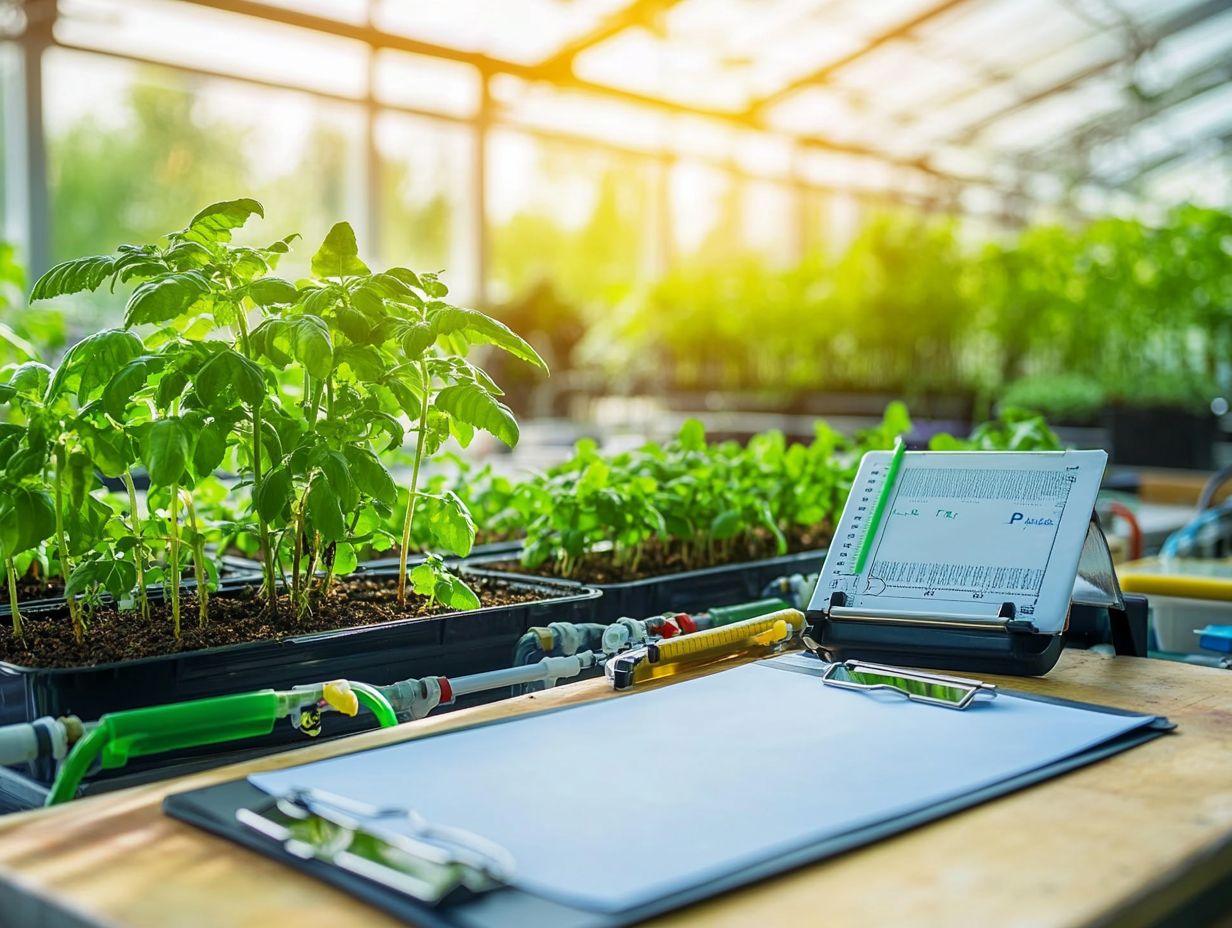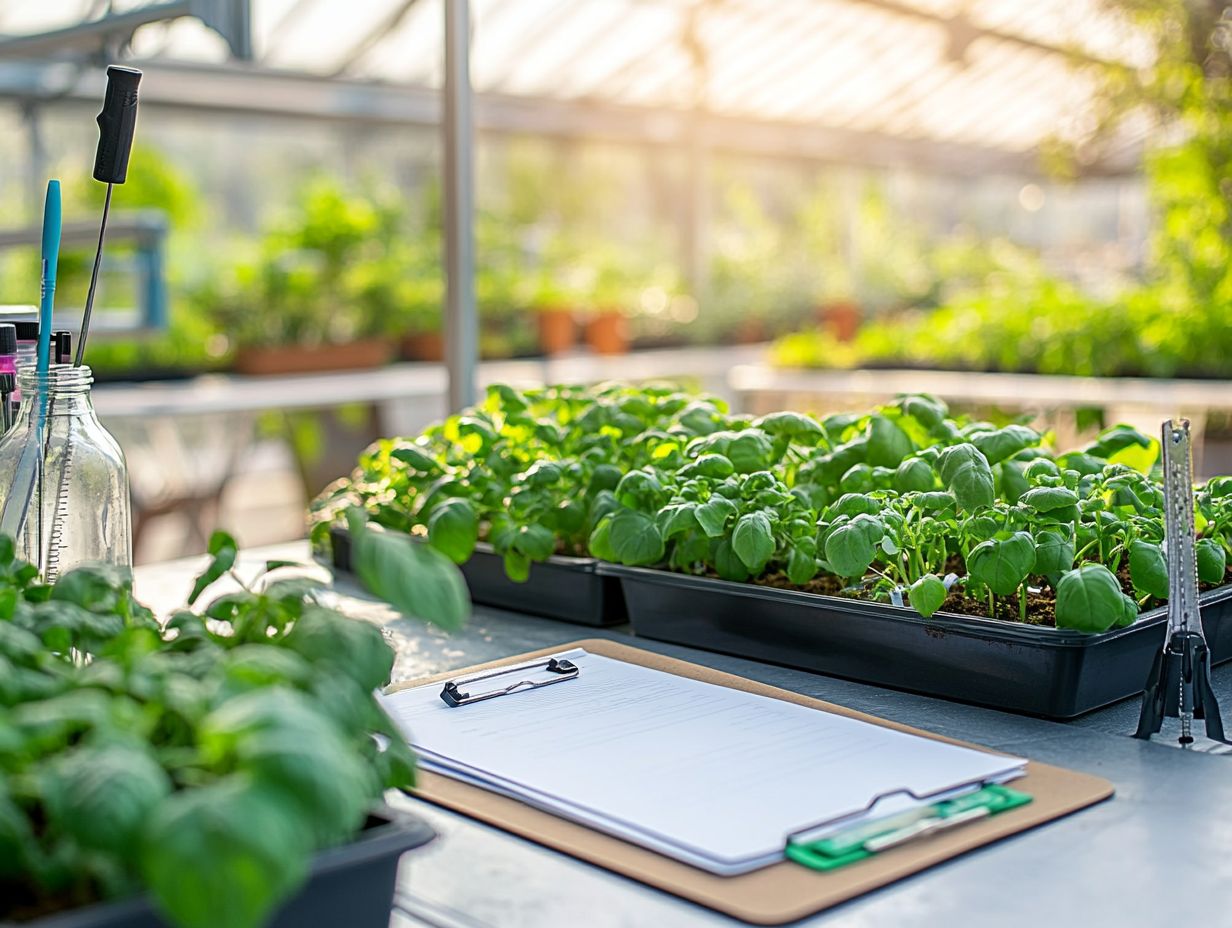Steps for Effective Hydroponic Troubleshooting
Hydroponics presents a transformative approach to cultivating plants without the need for soil. However, it comes with its own set of challenges.
Whether you re an experienced grower or just starting this green adventure, grasping how to troubleshoot common issues is crucial for sustaining a flourishing hydroponic garden.
This article delves into the most prevalent problems you may encounter in your hydroponic system. It guides you through effective troubleshooting steps and shares vital tips to ensure your system operates seamlessly.
Prepare to elevate your hydroponic experience!
Contents
- Key Takeaways:
- What is Hydroponic Troubleshooting?
- Common Issues in Hydroponic Systems
- Steps for Effective Troubleshooting
- Troubleshooting Tips and Tricks
- Frequently Asked Questions
- What are the steps for effective hydroponic troubleshooting?
- How do I identify the problem in my hydroponic system?
- What are some common causes of problems in a hydroponic system?
- How do I test water and nutrient levels in my hydroponic system?
- What should I look for when inspecting my hydroponic equipment?
- When should I seek expert advice for hydroponic troubleshooting?
Key Takeaways:

- Regularly check water quality to avoid issues such as nutrient deficiencies or chemical imbalances.
- Inspect equipment and components for any signs of damage or malfunction to prevent larger problems from arising.
- Monitor nutrient levels and plant health closely to catch any issues early and make necessary adjustments.
What is Hydroponic Troubleshooting?
Hydroponic troubleshooting involves pinpointing and addressing the common challenges that arise when using hydroponic systems. These systems enable you to grow crops in a soil-less medium, utilizing liquid that provides plants with essential nutrients for optimal growth.
This innovative approach is gaining traction in urban gardening as it allows you to cultivate plants in controlled environments. This maximizes yield while minimizing resource consumption. Understanding the intricacies of hydroponic gardening covering aspects like air circulation, humidity management, and pest control is crucial for your success.
Mastering these elements will help you sidestep issues such as root rot or leaf problems, ensuring your plants thrive.
Common Issues in Hydroponic Systems
Common issues in hydroponic systems can significantly affect your plants’ health. These issues often stem from various factors such as humidity, temperature, and plant diseases, including pests.
For example, root rot can develop due to overwatering or inadequate air circulation. Meanwhile, pests and algae can thrive in poorly controlled environments that lack proper humidity management.
Understanding these challenges is essential for you as a gardener to ensure your plants remain healthy and maximize yields in your hydroponic gardening endeavors, particularly focusing on water-efficient practices.
Identifying and Addressing Problems
Identifying and addressing issues in hydroponic gardening demands keen observation and a thorough understanding of plant health indicators. Signs like leaf discoloration or stunted growth could signal underlying problems within your nutrient solution or environmental factors.
By regularly inspecting your plants and their growing conditions, you can effectively troubleshoot potential problems before they escalate.
This proactive approach involves conducting visual inspections for pests or any abnormalities in stem structure. Routine checks of nutrient levels are equally crucial; even slight variations can significantly impact plant vigor.
Utilizing tools such as pH meters and EC meters enables you to maintain optimal conditions in the nutrient solution, ensuring your plants efficiently absorb essential minerals like calcium.
Quickly identify and solve these issues to keep your garden flourishing! By integrating these strategies and understanding hydroponic system maintenance, you’ll create a lush, thriving hydroponic garden that excites your senses!
Steps for Effective Troubleshooting

Effective troubleshooting in hydroponic gardening requires you to follow a series of systematic steps that guarantee optimal growth conditions for your plants. Start by assessing the water quality, then inspect your equipment and monitor nutrient levels.
By carefully analyzing these essential components, you can significantly enhance plant health while minimizing the risk of problems like root rot and pest infestations. For those managing systems, troubleshooting hydroponic system automation can further improve your setup. This meticulous approach will help you cultivate a thriving hydroponic ecosystem.
1. Check Water Quality
Checking water quality is an essential first step in your hydroponic troubleshooting journey. The nutrient solution must maintain precise levels of pH and electrical conductivity (EC) which measures how well the solution can conduct electricity, indicating nutrient concentration to nurture healthy plant growth.
By ensuring that your water is free from contaminants and properly balanced, you enable your plants to absorb those essential nutrients effectively. Keep an eye on your water quality to prevent any surprises that could harm your plants.
Monitoring pH levels, ideally between 5.5 and 6.5, allows the nutrient solution to remain accessible to your plants. It’s important to measure electrical conductivity, as it helps gauge the concentration of nutrients in the water; for most hydroponic systems, an optimal range is typically between 1.5 and 2.5 mS/cm.
Neglecting these checks can quickly lead to stressed plants and stunted growth, making it imperative for you to establish a consistent testing routine. By proactively addressing water quality concerns, you can create a thriving environment for your plants and watch them flourish.
2. Inspect Equipment and Components
Inspecting the equipment and components of your hydroponic system is crucial for ensuring everything runs like a well-oiled machine. Regular maintenance can save you from headaches caused by equipment failures that could lead to problems like root decay or inadequate air circulation.
You should routinely assess the water quality in the reservoir, as imbalances in nutrient concentrations can significantly impact plant health. It’s also important to keep a close eye on the pH level; an unstable pH can obstruct nutrient uptake, ultimately affecting growth rates and the quality of your yield. To avoid pitfalls in your hydroponic setup, be sure to check out common mistakes to avoid in hydroponics.
Evaluating pump performance is essential for ensuring proper water distribution. The air pump must also be inspected to guarantee optimal oxygenation, which is critical for robust root systems. By maintaining these key elements, you boost the efficiency of your setup and create a flourishing environment for your plants, allowing you to fully enjoy the rewards of your hydroponic investment.
3. Monitor Nutrient Levels
Monitoring nutrient levels is crucial in hydroponic gardening because plants depend on nutrient-rich water for optimal growth and development. By regularly assessing the nutrient solution for elements like calcium, you ensure that your plants receive the essential components they need to flourish.
A range of methods is available for precise monitoring, including testing kits and nutrient meters that deliver quick, reliable readings. These tools help identify current levels of vital nutrients and play a key role in preventing deficiencies or toxic excesses that could hinder plant health.
For example, an imbalance can result in stunted growth, yellowing leaves, or other distress signals. Understanding how to effectively balance these nutrients is vital for any gardener who aims to optimize yield and cultivate robust plants.
4. Examine Plant Health

Examining plant health is essential for spotting potential issues like diseases or pest infestations that could disrupt your hydroponic gardening success. By routinely checking for signs of stress such as discoloration or wilting you can implement timely interventions, turning to organic insecticides when needed.
Healthy plants should flaunt vibrant foliage and sturdy growth, signaling they re thriving. If you notice symptoms like yellowing leaves or stunted growth, it might be time to investigate further, as these could indicate nutrient deficiencies, overwatering, or insufficient light conditions.
Regularly monitoring pH levels and nutrient solutions is key to maintaining optimal conditions. If you catch pests early, you can use integrated pest management techniques to effectively mitigate their impact, incorporating beneficial insects and organic treatments that protect your plants while promoting sustainability in your gardening practices. Additionally, addressing light issues can be crucial, so refer to our guide on troubleshooting light issues in hydroponic gardening for more information.
5. Adjust Environmental Factors
Adjusting environmental factors such as humidity, air circulation, and temperature is essential for creating the perfect environment for your hydroponic plants. By effectively managing these variables, you can prevent issues like root rot and enhance the overall health of your plants.
To achieve optimal conditions, consider utilizing various tools like hygrometers for monitoring humidity, fans for ensuring effective air circulation, and thermostats to regulate temperature. Implementing these techniques creates a balanced growth environment where nutrient uptake and photosynthesis can flourish without interruption. Additionally, understanding electrical issues in hydroponics is crucial for maintaining these systems. Regularly evaluating these parameters allows you to make timely interventions, fostering stronger root systems and promoting vibrant foliage.
Understanding the specific needs of different plant species can guide your adjustments. This further optimizes your hydroponic setup and maximizes your yield potential. For detailed insights on managing light effectively, refer to troubleshooting hydroponic light schedules. Maintaining ideal environmental conditions is crucial for success in hydroponic gardening.
Troubleshooting Tips and Tricks
Troubleshooting tips can truly enable you to tackle any issues that may arise, ensuring your plants remain healthy and productive. Stay informed about best practices to cultivate seasonal crops confidently and enjoy a flourishing garden.
Proactive Maintenance and Prevention
Proactive maintenance and prevention are essential for the longevity and success of your hydroponic systems, enabling you to sidestep common pitfalls like root rot and pesky infestations. Focus on air circulation, humidity management, and routine equipment inspections to reduce the chances of issues.
To create the best conditions for your plants, establish a regular schedule that includes checking pH levels, nutrient concentrations, and water temperature. For effective monitoring, consider troubleshooting pH levels in hydroponic gardens. Ensure that your grow lights are positioned correctly and operating at peak efficiency to enhance photosynthesis, bolstering plant health even further.
Keep an eye out for any signs of pests or diseases. Discolored leaves or unusual mold growth can be early indicators of trouble. Act fast to tackle these problems and employ preventative measures, such as beneficial insects or organic repellents, to mitigate risks.
By integrating these strategies into your gardening practices, you won’t just aim for thriving hydroponic plants; you’ll make them a consistent reality.
Frequently Asked Questions

What are the steps for effective hydroponic troubleshooting?
- Identify the problem
- Check for common causes
- Test water and nutrient levels
- Inspect equipment
- Adjust environmental factors
- Seek expert advice if needed
How do I identify the problem in my hydroponic system?
The first step in effective hydroponic troubleshooting is to identify the problem. Look for signs of nutrient deficiencies, pest infestations, or equipment malfunctions. Take note of any changes in plant appearance or growth.
What are some common causes of problems in a hydroponic system?
Some common causes of problems include incorrect nutrient levels, poor water quality, pests, and equipment failure. It’s important to check these factors before moving on to other troubleshooting steps.
How do I test water and nutrient levels in my hydroponic system?
To test water and nutrient levels, use a pH meter and a device that measures the acidity and nutrient levels in water. These levels should be within the recommended range for the specific type of plants being grown.
What should I look for when inspecting my hydroponic equipment?
When inspecting equipment, look for any clogs, leaks, or malfunctions. Check pumps, filters, and tubing for signs of damage. Ensure all equipment is clean and functioning properly.
When should I seek expert advice for hydroponic troubleshooting?
If you have followed all the steps for troubleshooting and still cannot identify or fix the problem, it may be necessary to seek expert advice. Contact a hydroponic specialist or consult online forums for help.






